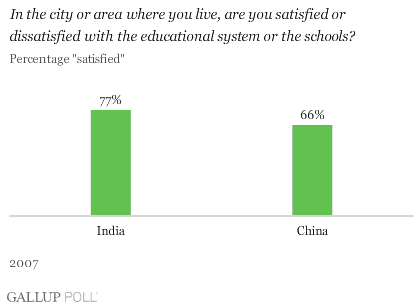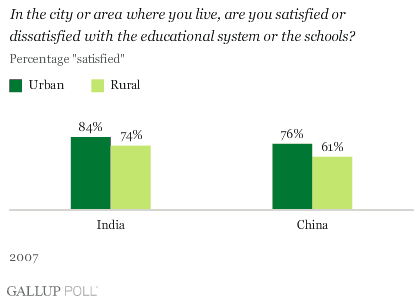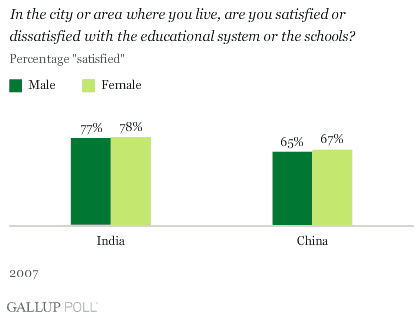WASHINGTON, D.C. -- The availability of a well-educated workforce has been key to economic expansion in India and China. Yet, despite China's legendary educational system, Indians (77%) are more likely than the Chinese (66%) to say they are satisfied with their schools.

That fewer Chinese are satisfied on this measure is surprising considering the country's renowned public education system known for its demanding coursework, daily homework and/or tutoring sessions, and rigorous exams. China's 91% adult literacy rate rivals wealthy, industrial Western economies, and is 30 percentage points higher than India's adult literacy rate of 61%.
However, according to recent Chinese media reports, many Chinese are growing dissatisfied with the perceived low return on their large investments in education. The Ministry of Education is also reportedly pushing schools to phase out the exam-dominated education system because it is turning out graduates without the experience and competence that the job market needs.
India's recent investment in education may be one reason why so many Indians are satisfied with their schools. Public spending on education has increased dramatically in the past several years to about 11% of the Indian budget. Now, the government plans to triple its education spending within five years.
Satisfaction With Education by Urban/Rural
Populations in both nations are urbanizing quickly, but solid majorities -- 60% of Chinese and 71% of Indians -- still live in rural areas where education generally lags behind that of urban areas. Yet, regardless of locale, Indians are more satisfied than the Chinese with the educational system. Nearly three in four (74%) rural Indians say they are satisfied with their schools versus about 6 in 10 (61%) rural Chinese. In both countries, satisfaction jumps among urbanites (84% satisfied in India; 76% in China), but the 15- point gap between China's urban and rural populations is somewhat larger than the 10-point gap between India's populations.

The 2007 Annual Status of Education Report (ASER) highlights India's progress in rural education, reporting that 98% of India's rural population now has access to public schools within 1 kilometer of their homes.
Satisfaction With Education by Gender
Gender gaps in literacy rates exist in China and India, but women in these countries are as likely as their male counterparts to express satisfaction in their educational systems. In general, women in both countries tend to be as likely, if not more likely, than men to be satisfied on several other aspects of their communities.

The literacy rate of Chinese women is about 87%, only somewhat below the approximately 95% of Chinese men who are literate. About two-thirds of Chinese women (67%) and Chinese men (65%) say they are satisfied with the schools. In India, where less than half of women can read or write (about 48% compared to approximately 73% of literate males), 78% of women and 77% of men express satisfaction with the educational system. In both countries, women tend to be as likely, if not more likely, than men to be satisfied on several other aspects of their communities.
Bottom Line
With global economic competition heating up between these two emerging economic giants, India is showing momentum in the educational arena, suggesting it could catch China in terms of overall literacy and educational attainment. With government spending and school enrollment increasing steadily -- about 4% of Indian children between the ages of 6 and 14 are not in school-- this strongly endorses that satisfaction is running high. Nonetheless, both governments can still do more to ensure equal access to quality education to all boys and girls in urban and rural areas.
Survey Methods
Results are based on face-to-face interviews with 4,175 adults in October 2007, aged 15 and older, in China. For results based on the total sample of national adults, one can say with 95% confidence that the maximum margin of sampling error is ±2 percentage points.
Results are based on face-to-face interviews conducted in India in April and May 2007 with a nationally representative sample of residents aged 15 and older. For results based on the sample of 3,186 Indians, one can say with 95% confidence that the maximum margin of sampling error is ±2 percentage points.